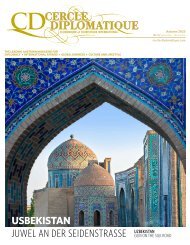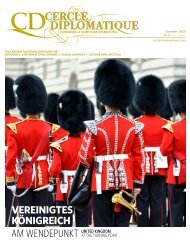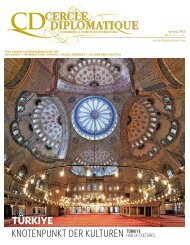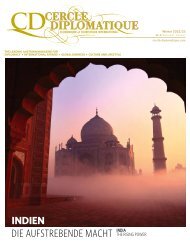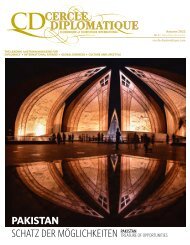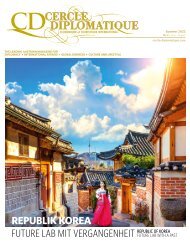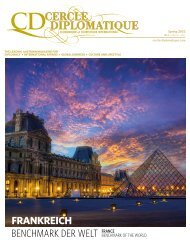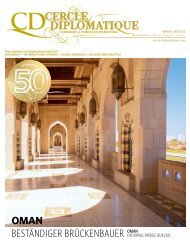CERCLE DIPLOMATIQUE - issue 04/2019
CD is an independent and impartial magazine and is the medium of communication between foreign representatives of international and UN-organisations based in Vienna and the Austrian political classes, business, culture and tourism. CD features up-to-date information about and for the diplomatic corps, international organisations, society, politics, business, tourism, fashion and culture. Furthermore CD introduces the new ambassadors in Austria and informs about designations, awards and top-events. Interviews with leading personalities, country reports from all over the world and the presentation of Austria as a host country complement the wide range oft he magazine.
CD is an independent and impartial magazine and is the medium of communication between foreign representatives of international and UN-organisations based in Vienna and the Austrian political classes, business, culture and tourism. CD features up-to-date information about and for the diplomatic corps, international organisations, society, politics, business, tourism, fashion and culture. Furthermore CD introduces the new ambassadors in Austria and informs about designations, awards and top-events. Interviews with leading personalities, country reports from all over the world and the presentation of Austria as a host country complement the wide range oft he magazine.
- No tags were found...
Create successful ePaper yourself
Turn your PDF publications into a flip-book with our unique Google optimized e-Paper software.
SAVOIR VIVRE
WEEKENDER
INFO
RIJEKA 2020
Das Programm umfasst an die
600 Veranstaltungen, die in
sieben Themeneinheiten
aufgeteilt sind.
Die Programmeinheit „27
Nachbarn“ etwa verbindet
Menschen, Sitten und
Lebensweisen auf den Inseln,
an der Küste, im Hinterland, in
den Bergen sowie in Rijeka
selbst. „Zeitalter der Mächte“
erzählt die abenteuerlichen
Geschichten der Mächte, die
in Europa regierten und es
verwalteten. Eine dritte
Einheit nennt sich „Küche der
Unterschiede“ und befasst
sich mit dem Thema
Migration und Minderheiten
– von Auswanderern und
Einwanderern, über nationale
Minderheiten bis hin zu
verschiedenen gesellschaftlichen
Minderheiten.
The programme includes
around 600 events that are
divided into seven different
thematic units. The
programme unit “27
Neighbours”, for example,
connects people, customs
and ways of life across the
islands, the coast, the
countryside, the mountains
and Rijeka itself. “Times of
Power” recounts the
adventurous stories of the
powers that ruled and
adminis-tered Europe. A third
unit is titled “Kitchen of
Diversity” and engages with
the topic of migration and
minorities – from emigrants
and immigrants, national
minorities and all the way to
the different social minorities.
rijeka2020.eu
sidenten Josip Broz Tito als schwimmende Residenz;
auf ihr empfing er Staatsgäste und Hollywoodstars.
It all begins on 1 February – with an opening ceremony
at the harbour. “Water, Work and Migrations
in the Port of Diversity” is the core theme
of the inaugural programme. Then, Rijeka – along
with Galway in Ireland – will be one of two European
Capitals of Culture for the year 2020.
It was a little surprising, to say the least, when it
was Rijeka that was selected several years ago to become
Croatia’s first European Capital of Culture,
rather than the better known and more popular cities
of Dubrovnik or Split with their ancient Roman
palaces, narrow Venetian alleyways and the glittering
promenades. Rijeka, the port and industrial
city? Rijeka, the city that most tourists merely pass
through on their way to the Istrian or Dalmatian
coasts? Well – if you take a closer look, you will see
that it was actually a quite excellent choice indeed.
Thanks to its long history, Rijeka has remained a
multicultural and diverse city. Central European history
spanning 100 or 150 years are uniquely exemplified
in the port and in-dustrial city. Rijeka belonged
to the Hungarian part of the Habsburg Empire, was
part of the Kingdom of Serbs, Croats and Slovenes
and the Socialist Federal Republic of Yugoslavia and
experienced both fascist and anti-fascist movements.
Today, it is the third biggest city in the independent
nation of Croatia. And now it is also a city in the European
Union.
Rijeka is not a picturesque city with Venetian
grandeur or Habsburg-style opulence. Rijeka is different.
Harder, rougher. Rijeka has an industrial background.
This is part of the city’s appeal. The testimonies
to its history immortalised in stone can be seen
everywhere. The Habsburg architecture, the Italianinfluenced
buildings, the realism of Yugoslav modernism.
It is, as any stroll through the city shows, a
brilliant blend of different cultures. But most importantly:
Rijeka has an active and vital art scene that is
unmatched in any other Croatian city.
One of the highlights of Rijeka’s year as a Euro-
Im Jahr 2020 werden sie Gassen, Straßen, Plätze und
Tunnels der Stadt zu Veranstaltungsorten. In 2020, they
will turn lanes, streets, squares and tunnels of the city into
venues.
pean Capital of Culture will be the carnival procession
on 23 February, one of the most significant traditional
events in Rijeka, and which will see several
carnival groups from other countries join. This will
be followed by a variety of exhibitions, theatre productions,
opera shows, concerts and conferences.
Inter-nationally celebrated artists, such as the opera
star Elina Garanča, will make appearances, as will
local artists. All of them will engage with the three
themes mentioned in the name of the programme,
which “symbolise the intertwining of Rijeka’s identity
with contemporary Europe: Water, Work and Migrations”.
In that sense, the programme of this year’s
European Capital of Culture will also be a statement
against nationalism and xenophobia.
One of the programme elements is titled “Love,
Death, Ecstasy” and will be dedicated to the “unknown”
Klimt who visited the city in 1885 and painted
five oil paintings for Rijeka’s theatre, known today as
the Croatian National Theatre Ivan pl. Zajc in Rijeka.
There will be a children’s festival, as well as festivals
of world music, gastronomy and contemporary
dance. And there is going to be a “Cup of the Capitals
of Culture”, where football teams from the various
European Capitals of Culture will encounter one
another.
Rijeka will, however, also use the occasion to advance
completely new cultural projects. Accordingly,
a new artistic quarter is being created on the premises
of the former Rikard Benčić factory site, the “art
kvart”, with a museum for modernism and contemporary
art, an arthouse cinema, a Rijeka city museum,
a city library and a children’s home.
One of the most interesting projects will only be
opened to the public toward the end of 2020: the renovated
“Galeb”. Galeb means seagull; a yacht of the
same name was built in 1938 in Genoa, Italy and served
Yugoslav President Josip Broz Tito as a floating
residence from 1953 to 1979 – here, he welcomed
heads of state and Hollywood stars.
PHOTOS: RIJEKA 2020
RIJEKA CITY OF
CULTURE —
PRIDE OF CROATIA,
CAPITAL OF EUROPE
Port of
Diversity
138 Cercle Diplomatique 4/2019





